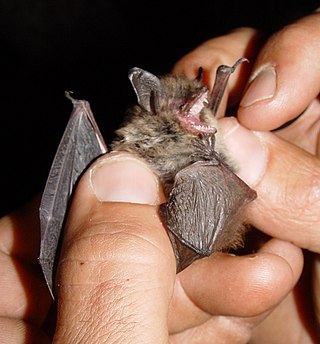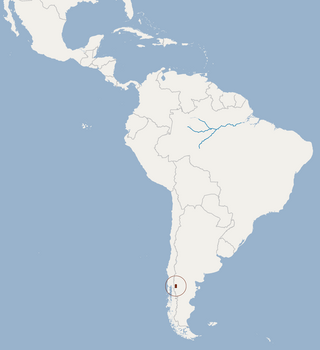
The mouse-eared bats or myotises are a diverse and widespread genus (Myotis) of bats within the family Vespertilionidae. The noun "myotis" itself is a Neo-Latin construction, from the Greek "muós and "oûs", literally translating to "mouse-eared".

The great evening bat is the largest bat in the vesper bat family (Vespertilionidae) and the only living species in the genus Ia. It is common to Eastern and Southeastern Asia, mainly living in areas with limestone caves at altitudes of 400–1,700 metres (0.25–1.06 mi). Their roost sites have been found both near the cave entrances and up to 1.5 kilometres (0.93 mi) within the cave systems.

The fraternal myotis is a species of vesper bat native to East Asia.

Hodgson's bat, also called the copper-winged bat or black-and-orange myotis, is a species of vesper bat in the genus Myotis, the mouse-eared bats. Favouring mountain forests, it is found throughout Central, Southeast, and East Asia, from Afghanistan to Taiwan. It is about 5 centimetres (2.0 in) long and is distinguished from most other species of bat in this range by its yellowish colouration.

The southern myotis is a species of vesper bat. It is found in Argentina and Australia.

The fringed long-footed myotis is a species of vesper bat in the family Vespertilionidae. It is found in China, Taiwan and Hong Kong.

Myotinae is a subfamily of vesper bats. It contains three genera: Eudiscopus, Myotis, and Submyotodon. Before the description of Submyotodon and analysis of its phylogenetics, as well as a phylogenetic analysis of Eudiscopus, the only member of Myotinae was Myotis.
The Taiwan broad-muzzled bat or Taiwan broad-muzzled myotis is a species of vesper bat found in Taiwan.
Submyotodon is a genus of vespertilionid bats, published as a new taxon in 2003 to describe a Miocene fossil species. Extant species and subspecies previously included in Myotis were later transferred to this genus. Species in this genus are referred to as broad-muzzled bats or broad-muzzled myotises.
The Moupin broad-muzzled bat(Submyotodon moupinensis) is a bat in the family Vespertilionidae endemic to southern China.
The reddish myotis is a species of vesper bat. It is endemic to Taiwan.

The orange-fingered myotis or red-painted myotis is a species of vesper bat endemic to the Philippines.

The reddish-black myotis or black-winged myotis, colloquially known as the "red bat" or "golden bat" in South Korea, is a species of vesper bat found throughout East Asia.
Weber's myotis is a species of vesper bat endemic to the Indonesian island of Sulawesi.

The long-tailed myotis is a species of vesper bat found in northern and eastern Asia.











